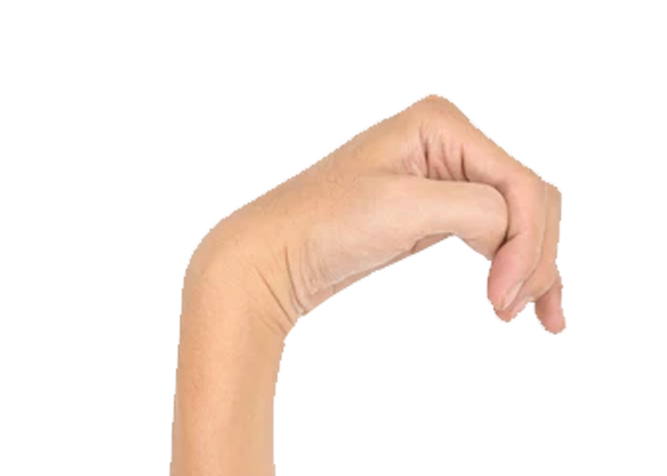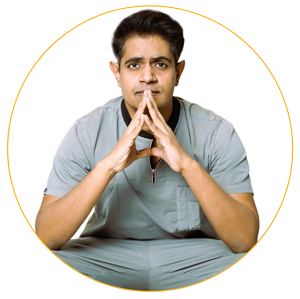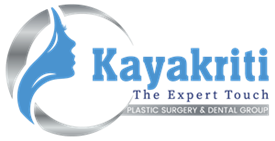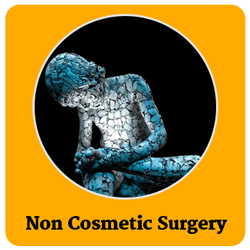Cerebral Palsy Hand Deformity
Spasticity of hand causes different contracted positions of hand with deformity causing problems in performing day to day activities in patients with cerebral palsy (CP).

Spasticity of hand causes different contracted positions of hand with deformity causing problems in performing day to day activities in patients with cerebral palsy (CP). Cerebral palsy is a developmental disorder which occurs because of injury to the brain before or after birth of the child during its developing years. CP is most commonly seen in low-birth-weight babies, premature babies, neonatal jaundice, genetic disorders, maternal infections and after any bleeding in the developing brain of the infant or the foetus in the mother's womb.
Contracted position depends on which part or location of brain is damaged. It can affect one or both the hands and /or lower limbs.
Spastic cerebral palsy presents with tightness of muscles and stiff joints, limited mobility, abnormal gait, walking on toes, contractures.
During the initial developing years of the child, these are very difficult to recognize because it usually presents with delayed milestones and usually it is diagnosed at the age of around 5 years.
Early detection of hand movement is important for better management. If the child has - thumb in the palm beyond one and a half years of age, neglection and shortening of the affected arm with spasticity then the diagnosis of spastic hand is confirmed.
Such children may also have associated disabilities like defective communication, vision, hearing, and mental impairment with history of fits. All these areas should also be investigated while assessing a child with spastic head.
Management of spastic hand
Management of hand deformities in children with cerebral palsy is done to develop and maintain hand manipulation skills, coordination and simple hand functions such as holding different objects for feeding and playing. In older children- writing skills, manipulation skills, activities of daily living skills and social skills have to be developed.
Management of such a deformity is a team effort involving parents, surgeons, physiotherapist, pediatricians, occupational therapist, nurses, and psychologists.
A) If the child is less than 4 years of age, then physical therapy, occupational therapy and positioning with splints should be tried so that their functional activities are made better
- Physical therapy :
- This is first line of treatment offered for spastic hand.
- This treatment is oriented to give as much as possible flexibility and suppleness to joints
- It includes range of motion exercises and stretching exercises.
- Improvement in Motor function is targeted
- Occupational therapy :
- The only goal of occupational therapy to enhance child's ability to perform day to day activities in home and school
- It focuses on strength improvement and bilateral hand coordination
B) If the child is more than 4 years of age, then evaluation should be done by all the members of the team and intensive therapy program should be chalked out for the child which involves physical and occupational therapy and splints. Botox can be given to the spastic and contracted muscles to loosen them so that they are amenable for physical therapy.
C) If the deformity has already set in or the contractor does not improve even after injection of Botox, then Surgery should be planned. The ideal age for surgery in children with cerebral palsy for treatment of hand deformity is between 8 to 12 years of age but surgery can be done even in adults.
The results of surgery in such patients are very gratifying and tremendously reduces the burden of parents who are immensely satisfied after the surgery of their child.
Prerequisites for surgery in children with cerebral palsy
- They should be intelligent enough to understand or interpret what is being told to him or her and to cooperate in post-operative re education
- They should have good family support
- They should be using the hand and have not stopped using it.
- They should have preserved basic sensations of touch and pain and should have ability to recognise physical characteristics of touched object like consistency, shape, size and surface
If the child has low IQ of less than 50, is not using the hand much and has less sensations of the hand then only cosmetic correction of the contractures should be done but if the child has IQ more than 50 with good control and sensations of the hand, then functional improvement should be aimed for.
- Surgical management is usually done in multiple stages
- Hand contractures or deformity should be managed before the lower limb to get them ready to hold the mobilization aid after the lower limb deformity correction
Types of surgery in children with cerebral palsy
Aim of surgery in children with hand deformities in cerebral palsy is to give a life to patient which is not dependent on some other individual. The different types of surgeries include-
- Muscle lengthening: Surgical lengthening of muscles is done to relieve tightness in the hands and fingers. This will improve wrist and hand movements with improvement in motor skills of hand.
- Tendon lengthening: This reduces contractures of hand. It requires joint oriented physiotherapy after surgery.
- Tendon transfer: This improves the functional outcome of hand and wrist. In this, a functional tendon is oriented to give movement to non-functional motion at hand or wrist. If power of functioning tendon is not adequate, power of that tendon increased with physical therapy then tendon transfer is performed.
- Tenotomy/ myotomy: Cutting of tendon or cutting of muscle may improve muscle function and increase control of the upper limbs and enhance ability to grasp objects with hands.
- Osteotomy: Bones are aligned in correct position to improve posture and function
- Arthrodesis: In severe cases of spastic hand, wrist arthrodesis done in functional position to improve the daily activities performance
Cerebral Palsy Hand Deformity Images
Indivisual results may vary from person to person.
These pictures are shown for the purpose of education only.


Know your surgeon better

Best plastic surgeon, Dr. Amit Agarwal is an American Board Certified, extensively trained, and best Plastic & Aesthetic surgeon in Lucknow. He is the Chief Plastic Surgeon heading the Department of Plastic, Microvascular, and Craniofacial surgery at Vivekananda Polyclinic and Institute of Medical Sciences, Lucknow, U.P, India. He maintains a busy practice at Avadh and Nishat Hospital and his own center - Kayakriti Plastic Surgery & Dental Center. He was formerly a Consultant in the Department of Plastic Surgery and Burns at the prestigious SGPGI, Lucknow.
MS, DNB (General Surgery) MCh, DNB (Plastic Surgery),
MNAMS, FACS, FICS, FRCS (Edinburgh, UK)
His Credentials
Three pillars of kayakriti
Privacy
We believe your experience with us should be comfortable and hassle-free to make it one of your best lifetime experiences for yours. We, here at the clinic, take full precautions to maintain your privacy in any manner. We also provide a staff who will receive you from the gate and take you to the chamber directly if you demand.
Trust
Our Surgeon is highly qualified and internationally certified with a team of skilled staff to perform any surgical or non-surgical treatment on your body.
Safety
When you plan to undergo any surgery you should always keep in mind that it's your body and it's a surgery. We, here always keep your safety a priority and will never recommend you to undergo any such procedure which is not safe for you. We also provide you with a detailed description of the complications which may occur after the surgery during the consultation as it's a surgical procedure so there may be some complications depending on the way your body reacts.
Kayakriti in news



Frequently Asked Questions
If you have flat or small breast and you want to improve your breast and hip contour ratio then you are a good candidate for it. The answer will be best provided after the first consultation with Dr Amit Agarwal.
Acute pain will be there for almost a week which gradually reduces and there will be soreness and swelling which may take up to 3 weeks to subside.
You can join your work and daily routines after a week of the procedure and can start exercising after 3 weeks of it.
Yes, you have to wear it round the clock unless we suggest you to remove it.
This surgery does not affect the ducts or the areas of the breast involved in milk production. Thus, it does not affect the breast feeding.
This surgery does not affect the ducts or the areas of the breast involved in milk production. Thus, it does not affect the breast feeding.












Kayakriti Plastic Surgery & Dental Center
D-43, Near Punjab National Bank, Rajajipuram, Lucknow, Uttar Pradesh - 226017, India
Phone No. +919695940009, +919695940006
Map Location





























Social Media Presence